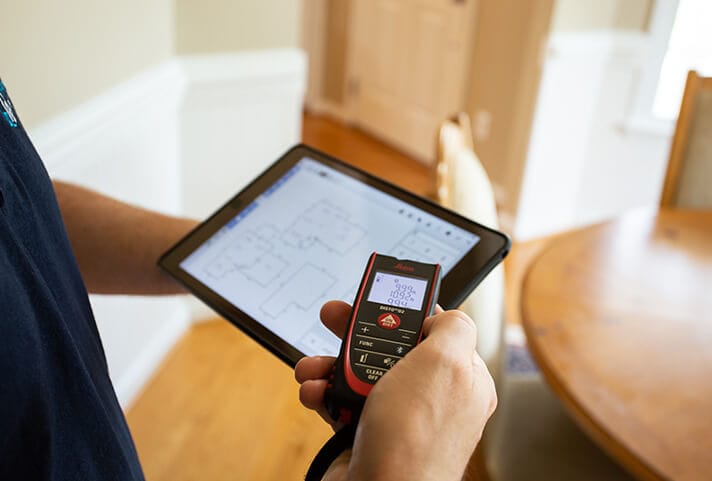Why Accuracy Matters in Home Measurements: Insights from Matt Harmon’s Seminar

For real estate professionals, homeowners, and buyers alike, home measurements hold incredible importance. From determining listing prices to ensuring accurate appraisals, precise square footage is critical. In his recent seminar, Matt Harmon—founder of Harmon Property Solutions, state-certified appraiser, and veteran in the field—provided a deep dive into the world of home measurements. His discussion covered the benefits of manual measurements, the pitfalls of newer scanning technologies, and the significant responsibilities real estate professionals face regarding square footage.
The Foundation of Accurate Measurements
Accurate square footage impacts a host of real estate elements: listing prices, buyer expectations, appraisals, and ultimately, successful transactions. Harmon emphasized that agents who misrepresent measurements risk disciplinary action from the North Carolina Real Estate Commission (NCREC), which places a high standard on listing accuracy. In fact, square footage discrepancies are among the top reasons for disciplinary complaints against agents, highlighting the need for careful attention to measurement accuracy.

Manual Measurement: Precision Over Convenience
Matt Harmon is a strong advocate for the traditional, manual measurement method. Equipped with an iPad, laser, and years of experience, Harmon’s team meticulously measures each home to ensure compliance with NCREC guidelines. Here are some of the primary benefits he shared about this approach:
- Thorough Room Assessment: When manually measuring, each room is assessed for ceiling height, wall thickness, heating sources, and finish quality—details that play a crucial role in determining if a space qualifies as “living area.” By measuring each room individually, professionals ensure every inch counts and meets standards.
- Handling Complex Designs: For properties with irregular features, such as angled walls or rounded rooms, a manual approach allows the measurer to adapt, ensuring a precise fit. Harmon shared fascinating examples, including a “geodesic dome” house in Wake Forest with a unique, complex structure that required a custom measurement approach.
However, the drawbacks include a higher time investment and complexity in dealing with irregular designs. Yet, this method remains favored among professionals who value accuracy over speed.

The Appeal and Limitations of Scanning Technology
In recent years, scanning technology has become increasingly popular, particularly with tools that allow users to 'scan' a home quickly using a smartphone app or a dedicated scanning device, creating blueprint-style layouts. While this technology provides a convenient, user-friendly approach for generating home layouts, Harmon outlined several concerns:
- Potential for Inaccuracy: Scanning tools struggle with wall thickness, low ceiling areas, and room connectivity. Without hands-on verification, scans often miss significant structural details, leading to square footage discrepancies.
- Limitations in Identifying Non-Living Areas: The technology can easily mistake non-living spaces (such as garages or screened porches) for living areas. Harmon shared examples of scanned reports that included screen porches as living spaces due to the app’s limitations, which could mislead clients about the home’s actual size.
- Risk of Misrepresentation: Since the scanning tools can’t distinguish between living and non-living areas, agents can be unknowingly misrepresenting the property’s square footage. Furthermore, since these scans are rarely verified, they pose a significant risk for agents relying solely on the technology.
For real estate agents, it’s crucial to recognize these risks. Harmon advised agents to treat scans as estimates rather than definitive measurements, underscoring that agents are responsible for the accuracy of any measurements they use, even if provided by a professional scan.

Spotting Errors in Sketches and Verifying Accuracy
To protect clients and themselves, Harmon recommends that agents scrutinize any measurement reports for signs of inaccuracies. Here’s a quick checklist he provided:
- Inspect Dimensions: Are exterior dimensions visible? Rounded to the nearest foot, or measured to a tenth? Consistent, detailed measurements are a positive sign.
- Compare with Photos: Does the sketch align with photos? If a listing photo shows a room with vaulted ceilings, but the sketch depicts a flat ceiling, it’s a red flag.
- Verify Unique Spaces: For homes with unique features (like bonus rooms or screen porches), check if the sketch accurately reflects those features.
- Review Past Listings or Tax Records: When available, compare the current sketch with previous records to spot any drastic differences.
This verification process can save agents from potential legal issues and ensure transparency with clients. If discrepancies are found, Harmon suggests considering a “Square Footage Inspection,” a simple inspection to confirm details before moving forward.
NCREC Guidelines: The Agent’s Responsibility
One of the most significant takeaways from Harmon’s seminar was the NCREC’s guidance on measurements. North Carolina mandates that agents either measure the property themselves or hire a professional. Notably, even when a professional is involved, the agent holds responsibility for the measurement’s accuracy. Agents must therefore understand NCREC standards, particularly regarding living area specifications, which include ceiling height and wall thickness, to assess the accuracy of a sketch.
The NCREC has recently emphasized verifying measurements before listing them in the MLS. In fact, recent disciplinary actions have targeted agents on both the buying and selling sides who failed to ensure measurement accuracy, reinforcing the need for agents to conduct due diligence in the listing process.

Matt Harmon’s Advice to Realtors: Be Proactive, Not Reactive
Harmon believes agents should view measurement accuracy as a core part of their service, not a last-minute add-on. By recommending a verification sketch during the buyer’s due diligence period, agents can demonstrate their commitment to providing a comprehensive and accurate view of the property. He suggests that agents treat a square footage verification similarly to a home inspection; it’s an investment that benefits both the buyer and agent by building trust and ensuring transparency.
Key Takeaways for Agents:
- On the Listing Side: If using a scan, always verify the measurement through a manual sketch. Inform sellers about potential discrepancies that may arise with automated measurements.
- On the Buyer Side: Recommend a “Square Footage Inspection” to safeguard against errors. This can reveal any discrepancies in the recorded square footage, benefiting the buyer and potentially providing negotiation leverage.
Closing Thoughts: Elevate Professional Standards
With rapidly advancing technology, the allure of speed and simplicity is understandable, but Harmon’s seminar served as a reminder that accuracy should remain paramount. Whether you’re a seasoned agent or just starting, understanding the nuances of property measurement can set you apart in a crowded market. By ensuring accurate measurements and following NCREC guidelines, agents can build trust, enhance transparency, and provide clients with the clarity they need.
For more insights into Matt Harmon’s measurement practices and how Harmon Property Solutions is leading the way in precise, reliable home measurements, visitharmonps.com.


